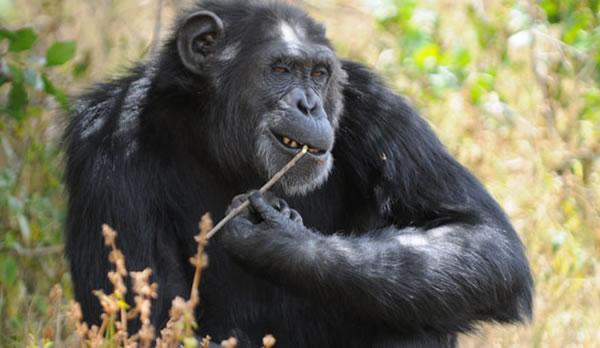 为什么猿类不会说话?
为什么猿类不会说话?
Why Can’t Apes Talk?
译文简介
为什么猿类不会说话?
正文翻译

We all know that parrots can talk. Some people may have even seen elephants, seals, or whales mimicking speech sounds. So why can’t our closest primate relatives speak like us? Our new research suggests they have the right vocal anatomy but not the brainpower to use it.
我们都知道鹦鹉会说话。有些人甚至见过大象、海豹或鲸鱼模仿人类声音。那么为什么我们的灵长类近亲不能像我们一样说话呢?我们的新研究表明,他们拥有解剖学上的发声器官,但是却没有使用这些发声器官的脑力。
Scientists have been interested in understanding this phenomenon for centuries. Some have argued that nonhuman primates didn’t have the right-shaped body parts to make the same sounds as we do, and that human speech evolved after our speech organs changed. But comparative studies have shown that the form and function of the larynx and vocal tract is very similar across most primate species, including humans.
几个世纪以来,科学家们一直对这一现象很感兴趣。有些人认为,非人类灵长类动物没有人类这样合适的身体部位来发声,而且人类的语言是在我们的语言器官改变后进化的。但是比较研究表明,包括人类在内的大多数灵长类动物的喉和声道的形式和功能非常相似。
几个世纪以来,科学家们一直对这一现象很感兴趣。有些人认为,非人类灵长类动物没有人类这样合适的身体部位来发声,而且人类的语言是在我们的语言器官改变后进化的。但是比较研究表明,包括人类在内的大多数灵长类动物的喉和声道的形式和功能非常相似。
This suggests that the primate vocal tract is “speech ready” but that most species don’t have the neural control to make the complex sounds that comprise human speech. When reviewing the evidence in 1871, Charles Darwin wrote, “the brain has no doubt been far more important.”
这意味着灵长类动物的声道已经“准备好说话了”,但大多数灵长类动物没有神经控制来发出构成人类语言的复杂声音。查尔斯·达尔文在1871年回顾这些证据时写道:“毫无疑问,大脑的作用要重要得多。”
这意味着灵长类动物的声道已经“准备好说话了”,但大多数灵长类动物没有神经控制来发出构成人类语言的复杂声音。查尔斯·达尔文在1871年回顾这些证据时写道:“毫无疑问,大脑的作用要重要得多。”
Along with Jeroen Smaers from Stony Brook University in New York, I have been investigating the relationship between the number of different calls that each primate species can make and the architecture of their brains. For example, Golden pottos have only ever been recorded using two different sounds, while chimpanzees and bonobos use around 40.
我和纽约州立大学石溪分校的罗恩·斯迈尔共同研究了每种灵长类动物能够发出的不同叫声的数量与它们大脑结构之间的关系。举个例子,我们只记录到金熊猴使用了两种不同的声音,而黑猩猩和倭黑猩猩可以使用大约40种声音。
我和纽约州立大学石溪分校的罗恩·斯迈尔共同研究了每种灵长类动物能够发出的不同叫声的数量与它们大脑结构之间的关系。举个例子,我们只记录到金熊猴使用了两种不同的声音,而黑猩猩和倭黑猩猩可以使用大约40种声音。
Our recent study, published in Frontiers in Neuroscience, focused on two particular features of the brain. These were the cortical association areas that govern voluntary control over behavior, and the brainstem nuclei that are involved in the neural control of muscles responsible for vocal production. Cortical association areas are found within the neocortex and are key to the higher-order brain functions considered to be the foundation for the complex behavior of primates.
我们最近发表在《神经科学前沿》杂志上的论文重点研究了大脑的两个特殊特征。包括:控制行为自主控制的皮层联络区,以及负责发声的肌肉的神经控制的脑干核团。皮层联络区位于新大脑皮层,是大脑高阶认知的关键,是灵长类动物复杂行为的基础。
我们最近发表在《神经科学前沿》杂志上的论文重点研究了大脑的两个特殊特征。包括:控制行为自主控制的皮层联络区,以及负责发声的肌肉的神经控制的脑干核团。皮层联络区位于新大脑皮层,是大脑高阶认知的关键,是灵长类动物复杂行为的基础。
The results indicate a positive correlation between the relative size of the cortical association areas and the size of the vocal repertoire of primates. In simple terms, primates with bigger cortical association areas tended to make more sounds. But, interestingly, a primate’s vocal repertoire was not lixed to the overall size of its brain, just the relative size of these specific areas.
研究结果表明,灵长类动物大脑皮层联络区的大小与声波曲目的大小呈正相关。简单地说,大脑皮层联络区越大的灵长类动物往往能发出更多的声音。但有趣的是,灵长类动物的声波曲目与大脑的整体大小无关,而与这些特定区域的相对大小有关。
研究结果表明,灵长类动物大脑皮层联络区的大小与声波曲目的大小呈正相关。简单地说,大脑皮层联络区越大的灵长类动物往往能发出更多的声音。但有趣的是,灵长类动物的声波曲目与大脑的整体大小无关,而与这些特定区域的相对大小有关。
We also found that apes have particularly large cortical association areas, as well as a bigger hypoglossal nucleus than other primates. The hypoglossal nucleus is associated with the cranial nerve that controls the muscles of the tongue. This suggests that our closest primate relatives may have finer and more voluntary control over their tongues than other primate species.
我们还发现类人猿的大脑皮层联络区异乎寻常的大,舌下核也比其他灵长类动物大。舌下核与控制舌头肌肉的脑神经相连。这表明,与其他灵长类物种相比,与我们亲缘关系最近的灵长类物种可能更擅长自主地控制舌头。
我们还发现类人猿的大脑皮层联络区异乎寻常的大,舌下核也比其他灵长类动物大。舌下核与控制舌头肌肉的脑神经相连。这表明,与其他灵长类物种相比,与我们亲缘关系最近的灵长类物种可能更擅长自主地控制舌头。
By understanding the nature of the relationship between vocal complexity and brain architecture, we hope to identify some of the key elements that underlie the evolution of complex vocal communication in our ancestors, ultimately leading to speech.
通过研究声音的复杂性和大脑结构之间关系的本质,我们希望确定一些关键因素,这些因素是我们祖先利用复杂的声音交流并最终进化为语言的基础。
通过研究声音的复杂性和大脑结构之间关系的本质,我们希望确定一些关键因素,这些因素是我们祖先利用复杂的声音交流并最终进化为语言的基础。
评论翻译
很赞 ( 1 )
收藏
The origins of speech is a topic that has long been debated. The Société de Linguistique de Paris famously banned any further inquiry into the matter in its publication pages in 1866, as it was deemed to be far too unscientific. But much progress has been made in the last few decades thanks to a wide range of evidence, such as that from studies of communication in other species, fossils and, more recently, genetics.
语言的进化
语言的起源一直是学术界长期争论的话题。1866年巴黎语言学会禁止任何出版物对这个问题做进一步探究,因为他们认为这么做很不专业。但是,多亏了广泛的证据,比如对其他物种交流的研究、对化石的研究,以及最近对遗传学的研究,过去几十年这方面的研究取得了巨大突破,。
研究表明,一些灵长类物种,如长尾猴,可以使用“单词”来标记事物(我们称之为语义学)。有些灵长类甚至能用声音组成简单的“句子”(我们称之为句法)。这在语言的早期进化方面给我们提供了大量信息,也表明数百万年前我们和这些灵长类的祖先们就使用这些语言元素了。
化石记录也提供了更多证据。语言本身显然不会变成化石,所以研究人员只能在已灭绝人类亲属的骨骼残骸中寻找代理证据。例如,一些研究人员认为舌骨(声道中唯一的骨头)的位置和形状可以为我们提供一些语言起源的信息。
同样,其他研究人员认为胸椎管(连接胸腔和神经系统)的直径,或者舌下神经管(神经通过这个器官传递到舌头),可以提供一些关于呼吸或语言产生的信息。中耳小骨的大小和形状可能会给我提供一些关于语言感知的信息。但是,总的来说,化石记录太少了,无法得出有力的结论。
最后,通过对人类和其他灵长类进行遗传学比较,我们对语言的起源就有了更深的了解。人们普遍认为FOXP2基因似乎与语言有关。如果这个基因发生突变,就会导致学习困难,而且很难做出复杂的口型,并导致一连串的语言缺陷。
长期以来,人们一直认为人类FOXP2基因的DNA序列变化是与我们独特的语言能力相关的独特特征。但最近的研究表明,一些灭绝的人类近亲中也存在这种类型的基因突变,而这种基因(或者语言本身)的变化可能比我们之前认为的要古老的多。
技术的发展,比如对灭绝物种的古老DNA测序的进一步研究,以及对语言神经生物学知识的进一步了解,肯定会带来进一步的巨大飞跃。但这个有争议且复杂的领域的未来很可能取决于大规模的、多学科的合作。像我们这样比较不同物种特征的比较研究,是达尔文使用的主要工具。毫无疑问,这些研究将继续为我们行为这一不可思议方面的进化提供重要的信息。